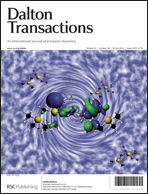This recent Dalton Transactions cover is by Nikolas Kaltsoyannis and team from UCL and my PhD supervisor, David Antonelli. Doing a PhD in hydrogen storage materials myself, I thought that this would be a good opportunity to blog about some of our group’s research…
UCL and my PhD supervisor, David Antonelli. Doing a PhD in hydrogen storage materials myself, I thought that this would be a good opportunity to blog about some of our group’s research…
The big challenge in hydrogen storage materials research is to develop materials that have a high storage capacity, are fully reversible, and can operate at ambient temperature and pressure. Our group have previously reported chromium hydrazide gels that store hydrogen via the Kubas interaction. The material has a gravimetric hydrogen storage performance of 3.2 wt% at 298K which corresponds to a volumetric capacity of 40.8 kg H2/m3, meeting the US Department of Energy’s 2015 target for volumetric density (40 kg/m3).
In this latest Dalton Transactions article, the Cr(II) binding sites were studied computationally to further study the interaction with H2. Strong evidence suggests that the metal-H2 interaction is Kubas type (confirming our previously reported results) – the Kubas interaction between a transition metal and H2 involves σ-donation from the filled H‑H σ-bonding orbital into an empty transition metal d orbital, and is strengthened by back-donation from a filled metal d orbital into the vacant σ* orbital of the H2 molecule. The binding model is similar to the Dewar-Chatt-Duncanson model for the bonding of CO ligands to transition metals.
Kaltsoyannis and team extended the system to incorporate other transition metal binding sites: Ti(II), V(II) and Mn(II). They found that H2 did not bind to Mn(II) suggesting that Mn(II) materials may not perform well for hydrogen storage. Hydrogen did bind to V(II) and Ti(II) and calculations indicate 5 and 7 wt% gravimetric storage respectively, surpassing the DOE’s goal for gravimetric storage.
This paper shows that materials based on V(II) and Ti(II) could potentially perform better than the experimentally-realised chromium hydrazide gels.
To find out more, read the full Dalton Transactions article now…
The Kubas interaction in M(II) (M = Ti, V, Cr) hydrazine-based hydrogen storage materials: a DFT study
Claire V. J. Skipper, Ahmad Hamaed, David M. Antonelli and Nikolas Kaltsoyannis










